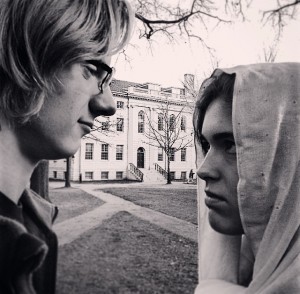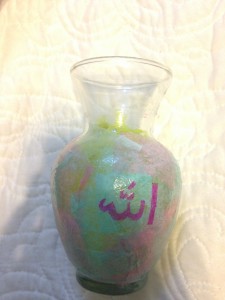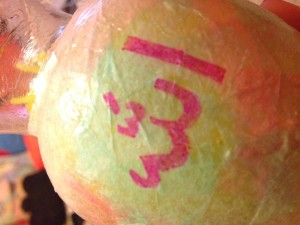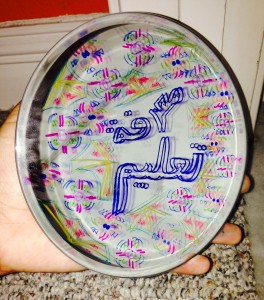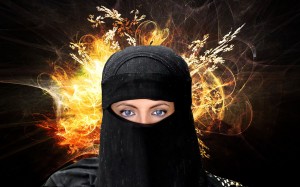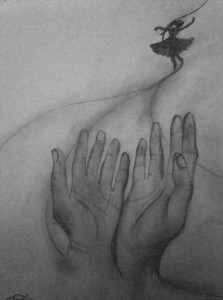“Most people are other people. Their thoughts are someone else’s opinions, their lives a mimicry, their passions a quotation.”
–Oscar Wilde
Identity. Without our own sense of self, who are we?
Although I learned many lessons from my time in Muslim Voices in Contemporary World Literature, the most important lesson I learned is how important one’s sense of self is for the development of an individual. Throughout the beautifully composed pieces of literature we read this semester, ranging from controversial novels to poems translated from another language, one theme that struck me most was the importance of identity. Even though the topics of the literature ranged from religious education to forbidden sexualities, one thing remained the same: all the characters struggled with their identity at one point or another.
From reading and eventually sympathizing with characters in readings like Madras on Rainy Days and The Complaint and The Answer, I realized that I had not fully immersed myself in thoughts concerning my own identity. What do I love most about life? What do I dislike most about society? Who will I be in ten years? Twenty years? Who am I now? Thoughts like these stormed through my mind like a hurricane, at first confusing me, but then coalescing together to give me a better insight into my inner self. As I read these readings, I began to think more. My previous opinions either amplified in their magnitude or slowly started to change into something new.
For instance, prior to reading Persepolis, a comic-style book illustrating life in Iran during times of war, I assumed that hijabs and burqas were articles of clothing related to the religion of Islam. However, as we read more, I realized that rather than acting as symbols of female oppression (like I previously assumed), these articles are symbols of anti-Westernization. Rather than being religious, the origins of the burqa lie in politics and unwanted intrusion from the West into the Middle East. Realities like this caused me to think twice about my assumptions and made me realize the importance of knowing, rather than assuming. Ignorance in the world has always irked me, but realizing that I was also veiled in a burqa of ignorance fired a passion within me. A passion not only to exterminate any spark of ignorance within me, but also to help eradicate this ignorance from strangers and friends alike.
In order to combat this ignorance within myself, I sought to educate myself more. In addition to actively engaging in the assigned literature, I also began reading into the news more. At first, I scoped through The New York Times and The Crimson (it’s hard not to take a peek when your door crate is erupting with a week’s supply of untouched Crimsons!) However, as I read more and started watching clips on CNN, I realized there must be some bias present. This led me to search newspapers from the Middle East, such as Al-Arab and The National. Getting perspective from both sides of the story helped extinguish ignorance and allowed me to further develop my identity.
In order to combat this ignorance within my friends, I tried something much simpler: I talked. I talk about The Saint’s Lamp and how religion and science can compliment one another, rather than contradict. I talk about The Reluctant Fundamentalist in light of the recent Ferguson case, sparking conversation about how discrimination is present all across the world and what we can do to overcome aesthetic boundaries. I talk about Madras on Rainy Days and how society makes people feel like they need to conform in order to belong, and how people should always feel comfortable in their own skin. I talk about We Sinful Women and how women are worth more than their beauty, how women are equal to men. I talk about The Complaint and The Answer and how we often are so caught up in the material aspects of the world that we often forget about the importance of introspection and spirituality.
In addition to talking, I used my creative responses to the literature as an avenue for sparking conversation. While embarking on the creation of this blog, I interacted with many people. Whether the interaction involved asking entryway mates to pose for a photograph or asking a friend for help in downloading Photoshop, the interactions led to conversation about religion, society, and more broadly, the world. As I created each blog post, I tried to emulate a certain part of each reading that struck out to me, and I aimed to make it my own. I tried to find a part of myself in each reading. Looking back on the posts now, I realize that many readings revolve around the same basic themes: empowerment, unity, and acceptance—all components in discovering and embracing one’s identity.
While some posts focus on certain parts of one’s identity—like the importance of embracing one’s sexuality in order to fully accept oneself—other aspects of one’s identity seem less concrete. Your identity doesn’t simply evolve around your physique, your identity transcends to your thoughts and beliefs. Furthermore, your identity is also defined by how you feel about other religions, about science, about education, and about yourself. I try to project these ideas in my creative responses by emphasizing the importance of self-discovery and identity through the differing mediums, subjects, and colors. In particular, I used color (like black and white) to accentuate the importance of grey. In life, different situations are often perceived as either right or wrong, conforming or not, black or white. However, creating this “black or white” mentality restricts people from realizing that there are more than just extremes. The grey perspective is what makes people different and allows different perspectives to form. The grey is what constitutes your identity.
Another theme I address on this blog is the importance of perspective. Every situation builds different individuals, creating a multitude of perspectives. Rather than believing that perspectives conflict, I believe that differing perspectives build upon each other to create a whole understanding of one another. While working on this blog, I realized that there are more than a hundred different interpretations of a single reading. When I was reading over our class’ responses to weekly readings, I realized that even though the reading was the same, every student’s interpretation of the reading was wildly different from the other’s interpretation. Although the common theme strung through was constant throughout, different students focused on different matters that they felt more personally about.
In order to show this, I try to take a different angle on some of my works. Friedrich Nietzsche said how, “There are no facts, only interpretations,” so, in order to address this thought, I try to create my own interpretations for different readings. I not only reflect on the main idea of the work, but I try to shed light on smaller issues and offer my commentary on these issues. I tried not to be objective, but rather, embrace the subjective nature of open-ended literature. I questioned certain elements in the text I didn’t agree with and questioned my reasoning in the elements I did agree with. I formed counterarguments for society’s affinity for creating a utopia and started to comprehend how it is easier to control a population of people if everyone thinks the same way. This epiphany made me appreciate different perspectives and pluralism even more, and led me to value diversity deeply.
So, it comes back to the question of identity. Without our own sense of self, who are we? I hope that this blog will address some of these elements of identity and help you gain a new perspective about different religions, society, and the world. Hopefully it will make you realize the importance of thinking for yourself and not letting the boundaries of society limit you from becoming your own person. Hopefully it will help you to remember not to let other people’s opinions dictate your thoughts and teach you about the importance of perspective and identity. At the least, I hope you enjoy!
How can a color, like red, or yellow, or blue
form opinions so strong that they differentiate me from you?
Black, white, everything in between:
What is the difference between what is felt and what is seen?
After decades and days and moments of trying,
The struggles, The strifes, The protests, The troubles
The oppressive chains of society emerging, passionate fires surging
Repressing, depressing, suppressing humanity’s instinct to be human
and infecting it instead with an infection more lethal than an uncontrolled virus
Infecting like a cancer that spreads—slowly, then all at once
Slowly affecting the most advanced of humankind
Leaving bodies, but metastasizing through the mind
Toxic thoughts arise, creating prejudice between color and religion and prosperity and size
Revaluing diversity, devaluing pluralism, and valuing the ignorance and conformity
that fortunately became veiled behind a desire for difference and an absence of uniformity
Memories of refusing to stand, dreams of children holding hands
“Equality!” they chanted! “Freedom!” they granted.
Hope appeared like a long lost love,
A love spreading like a cancer—slowly, then all at once
Infecting the most petrified of souls to reach out and try
Infecting bodies, but often leaving the mind
as souls feign acceptance and wait for time
to be replaced by time
to be replaced by time.
Everything has changed, but some things are still the same.
Some things still remain.
Some things take time.
I based this poem on the themes of identity and ignorance in The Reluctant Fundamentalist, My Son the Fanatic, and The Rainbow Sign. In all three works, individuals are discriminated against because of their religion, race, or place of origin. These readings, coupled with the current outbreak of the Ferguson and Eric Garner protest inspired me to write this poem. This poem speaks to question society and the way although we have evolved to change social constructs, the mentality of some remain the same. I allude to Rosa Parks and Martin Luther King Jr., and their efforts to restore peace, equality, and freedom. However, despite their movements and how so much of time has changed, we still divide individuals into constricting categories. I wrote this poem to self-reflect on these events and bring to light the issue of discrimination.
Samina Ali’s Madras on Rainy Days addresses concepts of gender, sexuality, and society. In the novel, Layla and Sameer are forced into a union of marriage by their parents’ wishes. However, their commitments are not to one another. Sameer is homosexual and desires to live in America to finally be free of societal repressions. He wants to embrace his sexuality and not be afraid to show the world who he really is. On the other hand, Layla struggles with her identity. Her parents are Indian, but she goes to school in America. She is constantly walking on the edge of both cultures, trying desperately to fit into open-minded, liberal, free-thinking America and conservative, tradition-based, one-minded India. Both Layla and Sameer struggle in trying to discover where they belong, and try to break free from conforming to society.
In order to reflect on these themes and comment on my own perspective of these ideas, I decided to capture my thoughts in a photograph. Depicted in this photograph (of two of my very helpful entryway mates!) is a tension caused from many sources. The man is shown taller than the woman, almost shadowing her, symbolizing how men are often viewed as superior in society. The light shines on his face, while her face is shown in the shade. This represents how the voices of women were often silenced. However, there is light all around her, demonstrating how she is desperately trying to break free from this societal norm. She is wearing a white veil, symbolizing the veil of purity women are expected to wear until marriage. The fury in her eyes shows her resistance to society’s norms and how even though she does not agree with society, she is forced to wear a façade of submissiveness. On the other hand, the man is shown in dark colors, expressing his internal conflict about his own sexuality and identity. His face is calm, but full of hopelessness. He looks vulnerable. Society views men as stronger, more certain, not vulnerable. But the expressions in his eyes reveal a vulnerability imposed by society’s harsh social constructs. The man and the woman are close to one another, but there is a distance between them. This shows how even though they are different; they are still one and the same. In the distance, there are two paths that converge into one. This convergence represents how even though their paths are different, they still lead to one common dream: they both want to discover themselves and be accepted for who they are.
While reading The Qassi Lamp, many questions piqued my interest. The story addressed the perceived controversy between religion and science. Going to a school like Harvard, where only 6% of the undergraduate class categorizes itself as “very religious” and 35% of the class is agnostic, the doubt many have for religion is somewhat contagious. Many a times I have questioned my beliefs, wondering if science could answer the questions I have about life better than my religion can. During this time, a close friend enlightened me with a simple story.
“Do you believe that there’s life in the sea beyond what is discovered?” He asked.
“Of course there is!” I responded.
“How do you know?” He questioned.
“Well, because some divers have seen it!” I exclaimed.
“Have you seen this life?” He smirked.
“No…” I hesitated.
“Then how do you know it’s real?”
I stopped.
“You see, very few divers have gone to the depths of the ocean and told the world of the wonders they discovered. They tell us there is more. They tell us that we aren’t even close to discovering all of the sea creatures out there! But we believe them, even if we haven’t seen these creatures for ourselves. If this is the case, then seeing isn’t believing. Just like this, few have experienced God closely for themselves, and told the world about his magnificence. However, just because we have not reached that point, it doesn’t mean that it doesn’t exist. You have to believe.”
As I researched, read, and learned more, I realized that science is the how and religion is the why. They don’t contradict—they coalesce. In order to represent this thought, I created my own version of the qassi lamp, or the saint’s lamp. I took a clear glass vase as my base to represent how originally people had strong, pure beliefs in their religion. They did not doubt it. As years became decades and decades became centuries, layers of education covered the glass of faith. Layers of different colors, thoughts, theories, and ideas. However, the layers of science did not compromise belief in faith. Rather, it made the light more beautiful. Despite the controversies we have in the world today, the light of faith still shines through science. It still shines brightly. It doesn’t conflict with the layers, rather, it joins with the layers to shine even brighter—even more whole.
The Wedding of Zein explores the importance of education in creating an identity for oneself. For example, in the novel, the Imam’s education is the backbone for his authority and power. Knowing about the world around you and being a worldly person significantly enhances the perspective others have of you.
In order to reflect this idea, I drew an image on a mirror to show how education is the center of life. In the center of the mirror, education is scripted in Arabic. This is to symbolize how with education and knowledge, all things are possible. With a world absorbed in conforming to ignorance and closed-mindedness, it is difficult to remember that there is more out there than we think. So many of the horrors and atrocities around the world are attributed to miscommunications, misconceptions, and ignorance. Like His Highness the Aga Khan says, it is not a clash of civilizations, but a “clash of ignorance” that plagues our world today. Above the word education, it says, “to know.” This emphasizes the importance of not just being open-minded and opening your eyes to your surroundings, but also knowing and understanding the goods and bads in the world.
Surrounding the words education and knowledge is a flurry of embellishments, ranging from short disconnected lines to more floral patterns. The diversity of patterns and colors show how a diverse breadth of personalities and thoughts come together to form society and how even though we are all different, together we are beautiful. The surface of the artwork is a mirror, this symbolizes how as our education changes, we change. Our knowledge is the best reflection of who we really are.
In society, women are often viewed as inferior. Not just in Eastern societies, but also in Western societies. It is not said, but many aspects of modern culture suggest otherwise. Names of poems, like We Sinful Women, cater to the perception most have of women. Sin. Desire. Lust. Temptress. All are words associated with women. Women are expected to be silent. Women are expected to stand back. Women are expected to be veiled. Women are expected to be submissive. Women are expected to conform. But women are more than that.
We may be silent, but we have a voice. We may stand back, but we have the power to lead. We may be veiled, but we can see the whole world. We may be physically submissive, but we will never surrender our thoughts and opinions to you. We are expected to conform, but our thoughts may never conform.
This image depicts a veiled woman, with the world in her eyes. Behind her is a black screen, emerging from it a whirlwind of dark colors. This symbolizes how women are constantly forced to emerge from a world of cacophony and turmoil. They are perceived to wear a veil of innocence, a façade of ignorance. However, we women are not as ignorant as we seem. We see the whole world; we witness its happenings. We have our own thoughts, aims, and desires.
When we see the image, we are drawn into her eyes. Her beautiful stark different eyes. The only real burst of color in the image. From a distance, they look blue. Sharp, alluring, and blue. However, when we move in closer, we see the green contours that define the different boundaries of land on our planet. In a way, this symbolizes how from a distance we see the whole—since the ocean is the only aspect of the world that is shared by all people. As we move in closer, we can distinguish different countries and continents and determine the differences between them. We can see the differences that stem from the similarities. This shows how even though all women seem the same, we are still very different from each other.
Persepolis provides the story of a young girl named Marji in Iran during the 1980s. As a young girl, she is exposed to many different aspects of life that a child in a peaceful country would not normally be exposed to. Marji’s parents are activists and regularly attend political protests. To me, the most intriguing aspect of this story is how young Marji is thrust into a world of adulthood. Her childhood is truncated as a consequence of the environment around her.
Persepolis illustrates Marji’s story through a comic-style novel. In order to emulate her style, I created a comic-style depiction of a child unknowingly thrust into a world beyond her wildest imagination. In the center of the comic is a young girl, smug in her bubble of innocence. Although she is young, she believes that she is “a big girl now.” Around her, is a world of terror and turmoil. At the upper left corner is a jail cell, inside which is a malnourished man. This addresses the levels of excessive torture many individuals struggled to survive through. Under this, is a question mark with a black “X” over it. This symbolizes the birth and death of curiosity. Children are naturally curious, however, as Marji was exposed to more and more atrocities she was expected to endure rather than interrogate. Despite these predetermined expectations, Marji never stopped questioning and never repressed her curiosity. Beneath this, there is a little soap duck, mimicking the duck Marji’s uncle carved for her. This alludes to her childhood and state of innocence. Exactly opposite of the duck, there is a lit cigarette, representing Marji’s personal initiation into adulthood. Although she was forced into adulthood prior to her first cigar, this was her personal indicator of her coming of age. Encircling Marji are different weapons of murder—fire, guns, explosives, knives. Although they are very much all around her, they are not touching Marji. This shows how even though Marji was not physically affected by the turmoil, these aspects of her life affected her on a deeper mental, emotional, and psychological level. On the bottom of the strip there are two hearts, one black and one white. This symbolizes interracial relationships and the innocence yet perceivably unacceptable nature of them. Marji does not see anything wrong with two different people—different color, different class—to get married if they are in love. However, society believes otherwise. This contradiction between self v. society also heightens Marji’s curiosity and confusion. The entire piece is black and white, emphasizing how in Marji’s world, everything is either right or wrong. There is no grey in between.
Although An Egyptian Childhood proposes various thoughts that emphasize a wide range of themes, one theme that struck me in particular was the importance of music in Egyptian society. In the story, the boy explains of how music speaks to him and he recalls how the laments and eulogies of his mother moved him to tears. He remembers the dedication and incantations of Sufis performing zikr and revers the spoken word of the lyrical Quran, despite his plight with memorizing surats. Seemingly, it is as if such religious prayers and chants are songs of the soul.
After reading An Egyptian Childhood, I was inspired to create my own song of the soul, but through instrumental music instead of vocal music. (Mostly because I can’t sing!) I used the piano as my method of making music, and incorporated dynamics to emphasize the unspoken lyrics embedded into my song. Initially, the song starts slowly, an arpeggio of three notes strung one after another for a few measures. The notes are played softly and it seems like some notes are intentionally skipped. Every one of these notes played symbolizes a different aspect of life—religious, material, physical. Without one, something just seems amiss. The song progresses to a trill, showing the unity of the esoteric and exoteric world, and how both may seem to contradict, but really, they are in harmony. The measures after the trill sound mysterious, much like the mysterious nature of religion. It seems like the person is trying to get somewhere, and is close, but hasn’t reached his destination quite yet. This reflects the path to enlightenment and how finding God is a constant entity that can be very self-fulfilling both emotionally and spiritually. The repetition of the note D three times in the middle of the piece represents the climax—the person has felt God’s presence. After this, the song repeats again, but it is louder and smoother; there are not notes missing. It is whole; he is whole. This echoes how even though the person’s physical life is unchanged, he is happier, more alive, and rejuvenated from being one with God.
In Sow Fall’s The Beggar’s Strike, Fall expresses how beggars are a integral part of society. Much like a doctor, or a teacher, or a maid, begging is also an occupation that helps bring home money in order to feed the mouths of hungry children. The story also emphasizes the juxtaposition of dishonesty between the beggars and the donors, and how many donors have selfish motives when they donate. Rather than helping the impoverished because they wish an easier life upon them, individuals donate to wish a life of ease upon themselves. If I just give them money, maybe I can go about my day without being bothered again.
However, in my drawing, I try to pose a slightly different perspective. Rather than showing how beggars are a step on the ladder of society, I illustrate the relationship between beggars and wanderers. Wanderers are just people, like you and me. Wanderers are people who dare to dream and aspire to succeed.They may seem insignificant in the story of life, but their stories intertwine with the stories of other wanderers in almost unfathomable ways.
Looking objectively at my graphite sketch, one may just see a pair of hands and a ballet dancer. But despite the simplicity of the drawing, the meaning is intended to be much deeper. The hands are open, as if in prayer, asking for alms, forgiveness, prayer, hope… Anything. Unlike the stark, bold, edgy figurine of the wandering dancer, the hands of the man are aged, experienced, and full of life. On the contrary, the figurine of the wanderer is much smaller, showing how even the smallest of people can make the biggest of differences in someone’s life. The open hands of the man and the wanderer seem to be vastly separated, with only ribbons to connect them. The ribbons show how pervasively the paths of people like us and people in need intertwine, and how we often overlook the struggles of others to look over our own wants and desires. Rather than helping others in need, we often look the other way and close our eyes and hearts to reality and humanity. Instead, we selfishly pursue our own dreams, our own thoughts, our own successes. Instead, we pursue ourselves.
In Naguib Mahfouz’s Children of the Alley, Mahfouz tells the story of sons of Gebelawi who try to restore social justice in the alley outside Gebelawi’s grand estate. Interestingly, God is represented as Gebelawi and each of his sons is an allusion of a revered prophet from one of the three Abrahamic religions. I think it is particularly fascinating how Mahfouz decides to humanize idealized prophets and shows how even the most idealized and spiritual of figures have flaws. He also shows how religion is like a stream of events, all connected by stories, and differing only in their cultures.
I took this reoccurring concept in the book and decided to paint my interpretation of this theme. I believe that the Abrahamic religions are one in the same, and that all religions teach and preach the same morals and reasons for being a genuinely selfless human being. To me, the main difference between Judaism, Christianity, and Islam is that they were all set in different cultural contexts. Rather than being three separate entities, I believe that the stories of the three religions are continuous and interwoven. To show this viewpoint, I painted the world and drew white figurines holding hands in front of it. The blue and green colors of the world reflect the peace and tranquility of the world if there was no conflict and if individuals respected each other’s differing views and identities. The white color represents each messenger’s pure intention to restore social justice and make the world a better place. However, the human form of each individual symbolizes how even though each prophet created great change in the minds of their followers and stirred the world, they were all still just human beings. Lastly, the linked arms represents how religion is a continuous cycle and how there is a sense of unity between the faiths.
